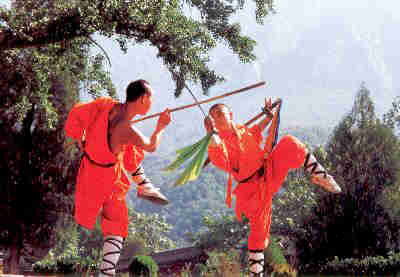| Chinese Way > Sports > Traditional |
|
|
Chinese Kung Fu
As man became more skillful in hunting and warfare, he also gradually developed dance for entertainment and relaxation. Early records suggest that dance was often the imitation of various animal movements, hence the Monkey Dance, the Bear Dance, the Bird Dance, and so on. The Book of History refer to them as 'the dances of hundred animals'. In addition, rudimentary sports appeared, such as Dance with Shield and Battle-Axe and Butting with Horns, both military exercises. The Dance with Shield and Axe, which was a martial dance depicting battle and training troops, demonstrate the early relationship between dance and fighting skill. Butting with Horns was competitive wrestling practiced by the soldiers. This sport was said to have been a training method before battle by the armies of the legendary Chiyou tribe of eastern China. The soldiers wore horns on their heads as a symbol of courage, and then butted each other during the contest. It was tradition that every feast should have a dance performance, which by the Han time would often take the form of a sword dance. Unarmed combat contest were also popular during the Han Dynasty. The rapid development in cavalry warfare of this period led to further improvements in skill using bladed weapons. According to the Book of Zhuang Zi, unarmed combat was a highly developed skill by the end of this period, with many methods of attack, defense, counter-attack and feints. Fencing was also fairly common at that time. It was especially popular among the people of the states of Wu, Yue and Zhao. Competitions were frequent, but because contestants wore inadequate protection, injuries were common during the bouts. In one fencing competition in the state of Zhao, more than 60 people were killed or wounded over a period of 7 days. In the state of Wu, scars on the body of face were common sight among the people. Nevertheless, the love of fencing went unabated among women as well as men. By the Qin Dynasty (221 - 207BC), competitions had developed stricter rules with referees, arenas and protective clothing. During the Han Dynasty (206BC - AD220), Kung Fu was developed further, the element of sport and dance now becoming more apparent. Many martial dances appeared, such as the Rapier Dance, the Broadsword Dance, the Twin-Halberd Dance and the Battle-Axe Dance. While these dances contained elements of attack and defense, other postures and techniques evolved which were designed clearly for callisthenic purposes. An historic record in 108 B.C. tells how people came from as far as 300 li (150km) around the capital to see a contest.
|
||
All rights reserved. Reproduction of text for non-commercial purposes is permitted provided that both the source and author are acknowledged and a notifying email is sent to us. |
||
 |
